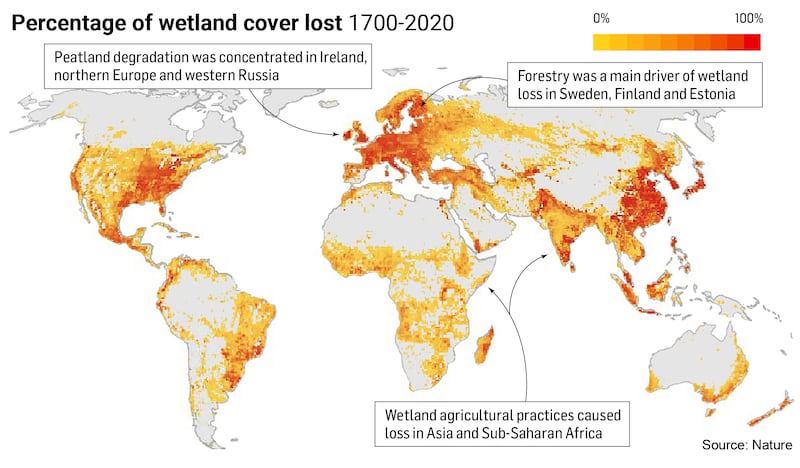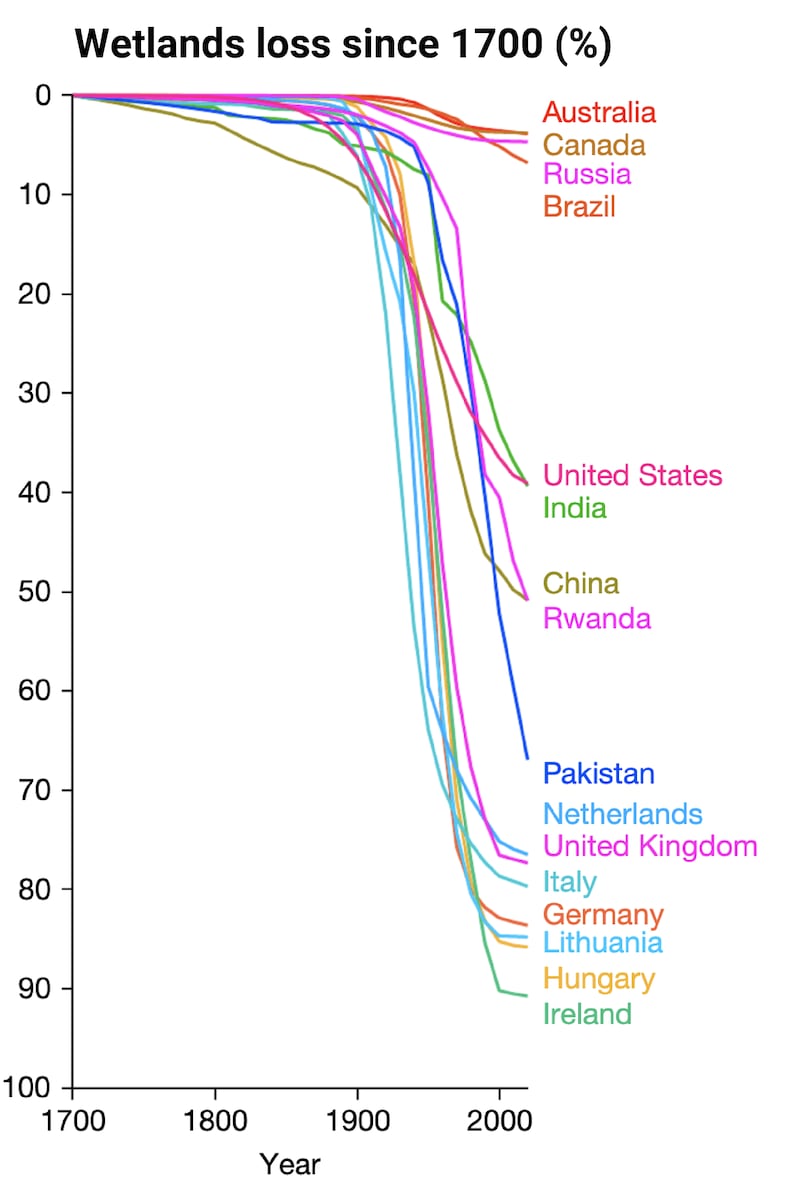Half the wetlands in Europe, continental US and China have been destroyed in the past 300 years, with Ireland faring worst of all countries, having lost more than 75 per cent of these crucial ecosystems, new research shows.
The findings coincide with the latest legal opinion from the European Court of Justice (ECJ) in a long-running case taken by the European Commission against Ireland, which finds “persistent” failure to introduce adequate conservation measures and to protect habitats including wetlands under the habitats directive.
The world lost about 20 per cent of its natural wetlands between 1700 and 2020, resulting in the disappearance of an area the size of India, according to the study published in Nature.

For the first time, researchers led by a team at Stanford University in the US combined global historical records with maps of today’s wetlands to create a more accurate picture.
RM Block
“For thousands of years, wetlands have been viewed by farmers as unproductive land, and drained. But in the past century the rate of destruction has increased rapidly. This, combined with the impact of the climate crisis, groundwater extraction, fires and rising sea levels has made wetlands among the most threatened ecosystems in the world,” the authors note.
Globally peatlands, which are wetlands with a thick waterlogged soil layer made up of dead and decaying plant material, store twice as much carbon as the world’s forests, so these are crucial ecosystems to preserve if climate targets are to be met. In Ireland, because of their extent in the midlands and elsewhere, they are potentially a globally significant store of carbon.
Wetlands are also important for biodiversity; up to 40 per cent of the planet’s species live and breed in them. They also purify water, protect against flooding and improve the physical wellbeing of people in urban areas.
Study author Dr Etienne Fluet-Chouinard and colleagues estimate 3.4 million square kilometres of inland wetlands have been lost since 1700.
That graph sent shivers down my spine even though I knew it already. It’s just jaw-dropping how Irish wetlands have just disappeared
— Peatlands expert Dr Florence Renou-Wilson of UCD
The most common causes of disappearance were drainage for upland crops; conversion to flooded rice fields; and urban development. Peatland degradation, however, was “concentrated primarily in Ireland, northern Europe and western Russia”.
Peatlands expert Dr Florence Renou-Wilson of UCD said the findings “put Ireland on the spot in the whole world, in how we damaged our wetlands”. Globally after centuries of destruction, drainage and extraction was stopped in most places in the 1950s, she said, but Ireland continued for decades.
This involved scaling up mechanised turf cutting, which was combined with afforestation – “the worst combination” in damaging such ecosystems. “At least we didn’t turn it into croplands,” she added.
In response to a graph indicating the extent of Irish wetland loss, she said: “That graph sent shivers down my spine even though I knew it already. It’s just jaw-dropping how Irish wetlands have just disappeared.”

The Ramsar Convention on Wetlands and the EU habitats directive were not really heeded in Ireland, Dr Renou Wilson said, which is “still failing to protect habitats in 2023″.
“People talk about destruction of the Amazon forest, but we have done exactly the same in Ireland,” she said. “Draining and cutting peatlands turns them into brown deserts. It also releases all the carbon they have stored away,” she added, noting that her research showed only about 20 per cent of Ireland’s peatlands were intact. She calls this remaining peat the country’s “last remaining wildlands”.
In collaboration with the EPA, she is studying how to protect intact wetlands and restore those that have been degraded. While wetlands in Ireland are mostly peatlands, they also include turloughs and salt marshes.
The latest ECJ opinion, issued this week from advocate general Tamara Ćapeta, finds persistent failure by Ireland to protect habitats and wild fauna and flora.
She agreed Ireland was “systematically establishing conservation measures which are not sufficiently detailed and do not address all of the threats and pressures for the habitats and species on each site”.
Ireland contains a number of priority habitat types and species that are in danger of disappearance in the Atlantic biogeographical region, she said. “For instance, blanket bogs are a certain kind of wetland habitat made up of soft, spongy ground consisting mainly of partially decayed plant matter called peat, which has built up slowly over thousands of years in areas where the climate is cool and wet. They are extremely important, inter alia, for climate change, as they store millions of tonnes of carbon (peat-forming plants such as sphagnum moss and sedges remove carbon from the atmosphere).”
Despite some regions being very badly affected globally, the overall picture shows there is a lot left to save, Dr Fluet-Chouinard underlined. “This is good news – it’s actually not too late to protect the majority of the wetlands in the world.”
“Now that we know the extent that’s been lost – and the benefits that are lost with the wetlands – we can make more educated and informed decisions about how we want to manage our landscapes,” he added.
The research team looked at maps of wetlands, which are now mostly created using satellite imagery, and then worked their way back to older records, many from the 1900s, which have been digitised. They looked at more than 3,000 land use and land drainage records. Data on how much land was drained before 1850 is patchy, which could mean the loss of wetlands is as high as 35 per cent.
The Convention on Biological Diversity agreement, signed at Cop15 in Montreal last December, committed to protecting 30 per cent of land, sea and inland water by 2030, in a landmark decision that will provide significant protection for freshwater ecosystems.
















